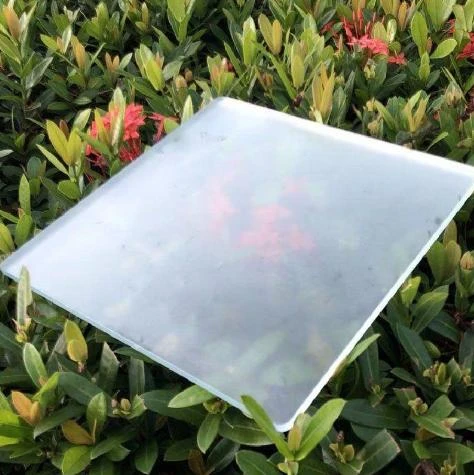The float glass manufacturing process is a marvel of modern engineering, transforming raw materials into smooth, defect-free sheets of glass that are fundamental to numerous industries. This innovative process is not only industry-standard but also a testament to the evolution and precision of glassmaking.

Float glass production begins with the careful selection of raw materials silica sand, soda ash, and limestone. These materials are melted in a furnace at temperatures exceeding 1,700 degrees Celsius. The precise composition and purity of these raw ingredients are crucial; even minor impurities can lead to defects, affecting the final product's quality. This expertise in selecting raw materials underscores the importance of a well-established supply chain and rigorous quality control protocols.
Once the raw materials are melted into a molten glass mix, the next step is the float bath process, where the molten glass is carefully poured onto a bath of molten tin. Here, it spreads out evenly and forms a smooth, flat surface, driven by gravity and the balance of the material's weight on the tin's buoyant surface. The innovative use of molten tin ensures that the glass's underside is as smooth as the top, mitigating distortions and weaknesses. This stage demands a deep understanding of fluid dynamics and material science, highlighting the expertise required to maintain the exact temperature and consistency essential for high-quality production.

Cooling, known as annealing, is crucial in the float glass manufacturing process. The glass passes through a controlled cooling chamber called a lehr, where it gradually cools to prevent internal stresses. The annealing process is where expertise truly shines, as incorrect cooling could lead to brittleness or unwanted strength weaknesses in the glass. Engineers and technicians with deep knowledge in thermal dynamics and stress analysis oversee this stage to ensure durability and safety standards are upheld.
float glass manufacturing process
Inspecting the finished glass is where true quality assurance is seen. Automated systems and human inspectors work in tandem to detect imperfections such as bubbles or impurities. Consistent quality checks rooted in experience and technological advances, guarantee every sheet meets strict industry standards for applications ranging from architectural to automotive sectors.
The float glass manufacturing process represents authoritative innovation in materials science and engineering. It has propelled the industry to new heights of reliability and quality, providing a product that meets stringent safety and aesthetic requirements globally. Trustworthiness in this context is established through the adoption of certified processes and international standards, which dictate the operational and safety measures observed throughout manufacturing.
In conclusion, float glass manufacturing is a sophisticated blend of expertise, technological innovation, and rigorous quality control. Each stage, from raw material selection to final inspection, demands a high level of technical know-how and reliability, ensuring a product that has become indispensable in modern construction and advanced manufacturing sectors.
Such expertise cements float glass manufacturing as not merely a process but a paragon of precision and quality in the glass industry.
 Afrikaans
Afrikaans  Albanian
Albanian  Amharic
Amharic  Arabic
Arabic  Armenian
Armenian  Azerbaijani
Azerbaijani  Basque
Basque  Belarusian
Belarusian  Bengali
Bengali  Bosnian
Bosnian  Bulgarian
Bulgarian  Catalan
Catalan  Cebuano
Cebuano  Corsican
Corsican  Croatian
Croatian  Czech
Czech  Danish
Danish  Dutch
Dutch  English
English  Esperanto
Esperanto  Estonian
Estonian  Finnish
Finnish  French
French  Frisian
Frisian  Galician
Galician  Georgian
Georgian  German
German  Greek
Greek  Gujarati
Gujarati  Haitian Creole
Haitian Creole  hausa
hausa  hawaiian
hawaiian  Hebrew
Hebrew  Hindi
Hindi  Miao
Miao  Hungarian
Hungarian  Icelandic
Icelandic  igbo
igbo  Indonesian
Indonesian  irish
irish  Italian
Italian  Japanese
Japanese  Javanese
Javanese  Kannada
Kannada  kazakh
kazakh  Khmer
Khmer  Rwandese
Rwandese  Korean
Korean  Kurdish
Kurdish  Kyrgyz
Kyrgyz  Lao
Lao  Latin
Latin  Latvian
Latvian  Lithuanian
Lithuanian  Luxembourgish
Luxembourgish  Macedonian
Macedonian  Malgashi
Malgashi  Malay
Malay  Malayalam
Malayalam  Maltese
Maltese  Maori
Maori  Marathi
Marathi  Mongolian
Mongolian  Myanmar
Myanmar  Nepali
Nepali  Norwegian
Norwegian  Norwegian
Norwegian  Occitan
Occitan  Pashto
Pashto  Persian
Persian  Polish
Polish  Portuguese
Portuguese  Punjabi
Punjabi  Romanian
Romanian  Russian
Russian  Samoan
Samoan  Scottish Gaelic
Scottish Gaelic  Serbian
Serbian  Sesotho
Sesotho  Shona
Shona  Sindhi
Sindhi  Sinhala
Sinhala  Slovak
Slovak  Slovenian
Slovenian  Somali
Somali  Spanish
Spanish  Sundanese
Sundanese  Swahili
Swahili  Swedish
Swedish  Tagalog
Tagalog  Tajik
Tajik  Tamil
Tamil  Tatar
Tatar  Telugu
Telugu  Thai
Thai  Turkish
Turkish  Turkmen
Turkmen  Ukrainian
Ukrainian  Urdu
Urdu  Uighur
Uighur  Uzbek
Uzbek  Vietnamese
Vietnamese  Welsh
Welsh  Bantu
Bantu  Yiddish
Yiddish  Yoruba
Yoruba  Zulu
Zulu 


